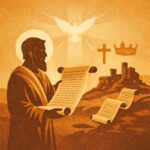| Host: | Jody Washburn |
|---|---|
| Guests: | Tiago Arrais and Mathilde Frey |
| Quarter: | The Book of Psalms |
| Lesson: | 13 |
| Sabbath: | March 30th, 2024 |
Leading Question: Stories often have an arc. There is tension, and the story draws us along because in the unfolding of each story, we see a bit of ourselves and what it means to be human. When you think of stories that have been powerful in your life, where does waiting fit in the storyline?
Scripture Focus: Psalm 27:14, Psalm 131, Psalm 126, Matthew 18:3
The Big Idea: Waiting in the Bible is active, not passive. Active waiting can involve silence and sound,
calm and activity. And while waiting is depicted primarily as a human activity, God also waits.
For Discussion:
In translations from Hebrew to English, the same Hebrew word is translated as both “wait” and “hope.” Consider the following examples.
Psalm 131:3 (Hebrew word yḥl)
“Israel, wait for the LORD from this time on and forever.” (NASB) “Israel, put your hope in the LORD both now and forevermore.” (NIV)
Psalm 27:14 (Hebrew word qvh)
“Wait patiently for the LORD. Be brave and courageous. Yes, wait patiently for the LORD.” (NLT) “Hope in Yahweh; Be strong and let your heart take courage; Hope in Yahweh.” (Legacy Standard Bible) “Trust in the LORD. Have faith, do not despair. Trust in the LORD.” (Good News Translation)
Discussion question: How are hoping and waiting related? How does the experience of waiting fit in the process of developing a trusting relationship with God?
The lesson draws on some of the Psalms of Ascent (Psalms 120-134) to help us reflect together on waiting in our individual and collective journeys with God. Both of these poems include rich imagery that brings to life various facets of relationship with God. Look over Psalm 126 and Psalm 131 and see how many kinds of imagery you can find. In what ways might these images deepen our understanding of hope and waiting?
Psalm 126:
1 When the LORD restored the fortunes of Zion, we were like those who dreamed. 2 Our mouths were filled with laughter, our tongues with songs of joy. Then it was said among the nations, “The LORD has done great things for them.” 3 The LORD has done great things for us, and we are filled with joy. 4 Restore our fortunes, LORD, like streams in the Negev. 5 Those who sow with tears will reap with songs of joy. 6 Those who go out weeping, carrying seed to sow, will return with songs of joy, carrying sheaves with them. Psalm 131: 1 My heart is not proud, LORD, my eyes are not haughty; I do not concern myself with great matters or things too wonderful for me. 2 But I have calmed and quieted myself, I am like a weaned child with its mother; like a weaned child I am content. 3 Israel, put your hope in the LORD both now and forevermore.
Discussion question: What imagery in these poems do you find particularly compelling? Why?
The lesson cites Matthew 18:1-3, where we find a description of Jesus standing a child among the people and telling the people gathered around that the key to the kingdom was becoming like little children.
Discussion question: What aspects of childhood could be instructive as we look for analogies for the place of hope and waiting in our faith life?





